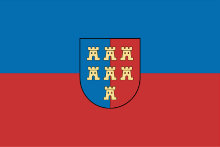Siebenbürger Sachsen (German) Siweberjer Såksen (Transylvanian Saxon) Sași transilvăneni (Romanian)[a] erdélyi szászok (Hungarian) | |
|---|---|
 | |
 Flag of the Transylvanian Saxons and the coat of arms of the Transylvanian Saxon University (Latin: Universitas Saxonum) during the Middle Ages in Romania | |
| Total population | |
| c. 11,400–c. 300,000[1][2][3] | |
| Regions with significant populations | |
| Romania (mainly Counties
| c. 11,400–c. 13,000 (2011)[4][5] |
| Languages | |
| |
| Religion | |
| Evangelical Lutheran majority with Reformed, Roman Catholic, and Unitarian minorities; initially staunchly Roman Catholic until the Reformation | |
| Related ethnic groups | |
| Luxembourgers, Germans, German diaspora, Flemings, Walloons, Austrians, and even French | |
Lived since the High Middle Ages onwards in Transylvania as well as in other parts of contemporary Romania. Additionally, the Transylvanian Saxons are the eldest ethnic German group in non-native majority German-inhabited Central-Eastern Europe, alongside the Zipsers in Slovakia and Romania (who began to settle in present-day Slovakia starting in the 13th century). | |
The Transylvanian Saxons (German: Siebenbürger Sachsen; Transylvanian Saxon: Siweberjer Såksen[6][7] or simply Soxen, singularly Sox or Soax; Transylvanian Landler: Soxn or Soxisch; Romanian: sași; seldom sași ardeleni/transilvăneni/transilvani; Hungarian: erdélyi szászok) are a people of mainly German ethnicity and overall Germanic origin —mostly Luxembourgish and from the Low Countries initially during the medieval Ostsiedlung process, then also from other parts of present-day Germany— who settled in Transylvania in various waves, starting from the mid and mid-late 12th century until the mid 19th century.
The first ancestors of the Transylvanian 'Saxons' originally stemmed from Flanders, Hainaut, Brabant, Liège, Zeeland, Moselle, Lorraine, and Luxembourg, then situated in the north-western territories of the Holy Roman Empire around the 1140s and 1150s.[8]
Alongside the Baltic Germans from Estonia and Latvia and the Zipser Germans (also sometimes known or referred to as Zipser Saxons) from Zips, northeastern Slovakia, as well as Maramureș and Bucovina, the Transylvanian Saxons are one of the three oldest German-speaking and ethnic German groups of the German diaspora in Central-Eastern Europe, having continuously been living there since the High Middle Ages onwards.[9][10] The Transylvanian Saxons are part of the broader group of Romanian Germans as well, being the eldest and one of the most important of all the constituent sub-groups of this ethnic community.
Their native dialect, Transylvanian Saxon is close to Luxembourgish. Nowadays, organisations representing the Transylvanian Saxons exist in Romania, Germany, Austria, Canada, and the United States (in the latter case most notably 'Alliance of Transylvanian Saxons').[11] Other smaller communities of Transylvanian Saxons can be found in South Africa and Australia as well as South America (for example in Argentina).
Cite error: There are <ref group=lower-alpha> tags or {{efn}} templates on this page, but the references will not show without a {{reflist|group=lower-alpha}} template or {{notelist}} template (see the help page).
- ^ The lowest figure displays data according to the 2011 Romanian census solely for the population living in Romania at that time.
- ^ The lowest figure indicates the approximate contemporary distribution mostly in Transylvania, central Romania, whereas the highest one applies worldwide.
- ^ "Siebenbürgen und die Siebenbürger Sachsen". Siebenbürgisches Kulturzentrum Schloss Horneck e. V. (in German). Retrieved 28 January 2023.
- ^ Nowotnick, Michaela (30 December 2016). "Herbst über Siebenbürgen". Neue Zürcher Zeitung.
- ^ According to the 2011 Romanian census
- ^ Verband der Siebenbürger Sachsen in Deutschland e.V. (i.e. Association of Transylvanian Saxons in Germany) (10 June 2009). "Bodo Löttgen: Positives Einwirken und Mut zur Veränderung". Siebenbürgische Zeitung (in German). Retrieved 23 February 2023.
- ^ Fadderwasch (25 July 2010). "Ken det Vergeßen". Siebenbürgische Zeitung (in German). Retrieved 23 February 2023.
- ^ Prof. Jan de Maere: FLANDRENSES, MILITES ET HOSPITES" A HISTORY OF TRANSYLVANIA (2013) Link: [1]
- ^ Siebenbürgisches Kulturzentrum Schloss Horneck E.V. "Transylvania and the Transylvanian Saxons". Schloss Horneck. Retrieved 9 April 2023.
- ^ Victor Rouă (14 January 2023). "The History Of The Zipser Germans In Central Europe". The Dockyards. Retrieved 19 February 2023.
- ^ "Alliance of Transylvanian Saxons". Encyclopedia of Cleveland History, Souvenir Book, 75th Anniversary of Alliance of Transylvanian Saxons (1970). Case Western Reserve University. 11 May 2018. Retrieved 22 February 2023.